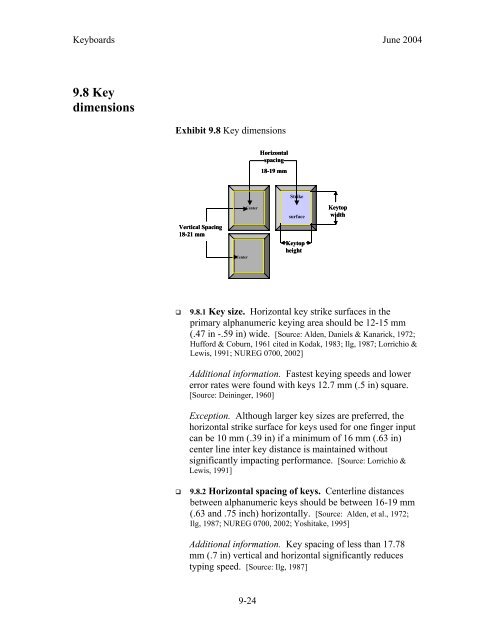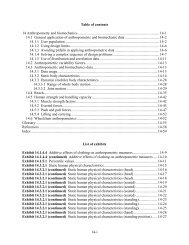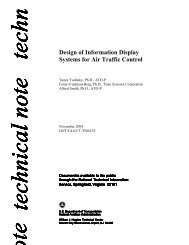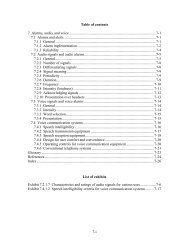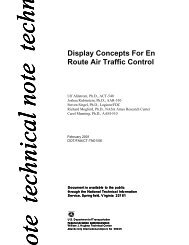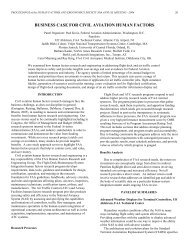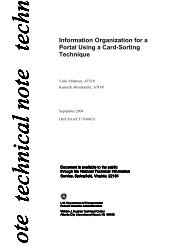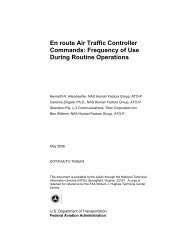Keyboards June 2004Additional in<strong>for</strong>mation. A separate numeric keypad allowsa shorter keyboard footprint, allowing better positioning<strong>and</strong> more room <strong>for</strong> pointing devices, such as a mouse,within easy reach. It also allows <strong>for</strong> right- or left-h<strong>and</strong>edusage, which can be matched to h<strong>and</strong> dominance <strong>and</strong>preference <strong>of</strong> <strong>the</strong> user.9.7.3 Location <strong>of</strong> numeric keypad. If numeric keypadsare integrated into a keyboard, <strong>the</strong> keypad should belocated to <strong>the</strong> side or above <strong>the</strong> primary keying area.[Source: Def-Stan-00-25, 1992]• 9.7.4 Arrangement <strong>of</strong> keys. Keyboards intended solely <strong>for</strong><strong>the</strong> entry <strong>of</strong> numbers shall have <strong>the</strong> numerals "1" through"9" arranged in a three by three array, with "0" centeredbelow <strong>the</strong> bottom row. [Source: Conrad & Hull, 1968; Loricchio& Lewis, 1991; Lutz & Chapanis, 1955; Marteniuk, Ivens & Brown,1996]9.7.5 Layout <strong>of</strong> keys. Numeric keypads should use ei<strong>the</strong>r<strong>the</strong> calculator or telephone arrangement <strong>of</strong> keys, preferably<strong>the</strong> telephone layout. [Source: Conrad & Hull, 1968; Klemmer,1971; Lutz & Chapanis, 1955; Marteniuk et al., 1996]Additional in<strong>for</strong>mation. Although <strong>the</strong> telephone layout(with numbers 1, 2, <strong>and</strong> 3 in <strong>the</strong> top row <strong>of</strong> keys) yieldsper<strong>for</strong>mance advantages, (higher speeds <strong>and</strong> lower errors),<strong>the</strong> calculator layout (with numbers 7, 8, <strong>and</strong> 9 in <strong>the</strong> toprow <strong>of</strong> keys) is commonly found on computers. Asper<strong>for</strong>mance is likely to be affected by cognitive factorslike familiarity, ei<strong>the</strong>r could be justified. [Source: Conrad &Hull, 1968; Klemmer, 1971; Lutz & Chapanis, 1955; Marteniuk et al.,1996]• 9.7.6 Consistency between keypads. When more than onenumeric keypad is used, <strong>the</strong> layouts between <strong>the</strong> keypadsshall be consistent. [Source: Conrad & Hull, 1968]Additional in<strong>for</strong>mation. Switching between telephone <strong>and</strong>calculator layouts <strong>for</strong> numeric keypads causes significantper<strong>for</strong>mance decrements. [Source: Conrad & Hull, 1968]9-23
Keyboards June 20049.8 KeydimensionsExhibit 9.8 Key dimensionsHorizontalspacing18-19 mmVertical Spacing18-21 mmCenterCenterStrikesurfaceKeytopheightKeytopwidth9.8.1 Key size. Horizontal key strike surfaces in <strong>the</strong>primary alphanumeric keying area should be 12-15 mm(.47 in -.59 in) wide. [Source: Alden, Daniels & Kanarick, 1972;Huf<strong>for</strong>d & Coburn, 1961 cited in Kodak, 1983; Ilg, 1987; Lorrichio &Lewis, 1991; NUREG 0700, 2002]Additional in<strong>for</strong>mation. Fastest keying speeds <strong>and</strong> lowererror rates were found with keys 12.7 mm (.5 in) square.[Source: Deininger, 1960]Exception. Although larger key sizes are preferred, <strong>the</strong>horizontal strike surface <strong>for</strong> keys used <strong>for</strong> one finger inputcan be 10 mm (.39 in) if a minimum <strong>of</strong> 16 mm (.63 in)center line inter key distance is maintained withoutsignificantly impacting per<strong>for</strong>mance. [Source: Lorrichio &Lewis, 1991]9.8.2 Horizontal spacing <strong>of</strong> keys. Centerline distancesbetween alphanumeric keys should be between 16-19 mm(.63 <strong>and</strong> .75 inch) horizontally. [Source: Alden, et al., 1972;Ilg, 1987; NUREG 0700, 2002; Yoshitake, 1995]Additional in<strong>for</strong>mation. Key spacing <strong>of</strong> less than 17.78mm (.7 in) vertical <strong>and</strong> horizontal significantly reducestyping speed. [Source: Ilg, 1987]9-24
- Page 1 and 2: Draft for review and commentDOT/FAA
- Page 3 and 4: Draft for review and comment1. Repo
- Page 5 and 6: Draft for review and commentTable o
- Page 7 and 8: Draft for review and commentEach
- Page 9 and 10: Draft for review and commentThe res
- Page 11 and 12: Draft for review and comment
- Page 13 and 14: Draft for review and commentList of
- Page 15 and 16: Keyboards June 20049.1.4 Use in col
- Page 17 and 18: Keyboards June 20049.2.4 Activity d
- Page 19 and 20: Keyboards June 2004e. Pronation/sup
- Page 21 and 22: Keyboards June 20049.4 Wrist/Palmre
- Page 23 and 24: Keyboards June 20049.5 Keyboardphys
- Page 25 and 26: Keyboards June 20049.5.1.6 Keyboard
- Page 27 and 28: Keyboards June 20049.5.2 Keyboard l
- Page 29 and 30: Keyboards June 20049.5.2.2 Grouping
- Page 31 and 32: Keyboards June 20049.6.1 Toggle key
- Page 33 and 34: Keyboards June 20049.6.3.5 Consiste
- Page 35: Keyboards June 20049.7 Numerickeypa
- Page 39 and 40: Keyboards June 20049.9 Key labeling
- Page 41 and 42: Keyboards June 20049.10 Keyactivati
- Page 43 and 44: Keyboards June 20049.10.7 Key repea
- Page 45 and 46: Keyboards June 2004Exhibit 9.12.b A
- Page 47 and 48: Keyboards June 2004Exhibit 9.12.g V
- Page 49 and 50: Keyboards June 20049.12.1 Split key
- Page 51 and 52: Keyboards June 20049.14 Membranekey
- Page 53 and 54: Keyboards June 20049.15.7 Colored k
- Page 55 and 56: Keyboards June 2004GlossaryABC keyb
- Page 57 and 58: Keyboards June 2004Homing timeKey f
- Page 59 and 60: Keyboards June 2004ReferencesAaras,
- Page 61 and 62: Keyboards June 2004Conrad, R., & Lo
- Page 63 and 64: Keyboards June 2004Henning, R., Jac
- Page 65 and 66: Keyboards June 2004Marteniuk, R. G.
- Page 67 and 68: Keyboards June 2004Rempel, D., Bach
- Page 69: Keyboards June 2004Swanson, N. G.,


